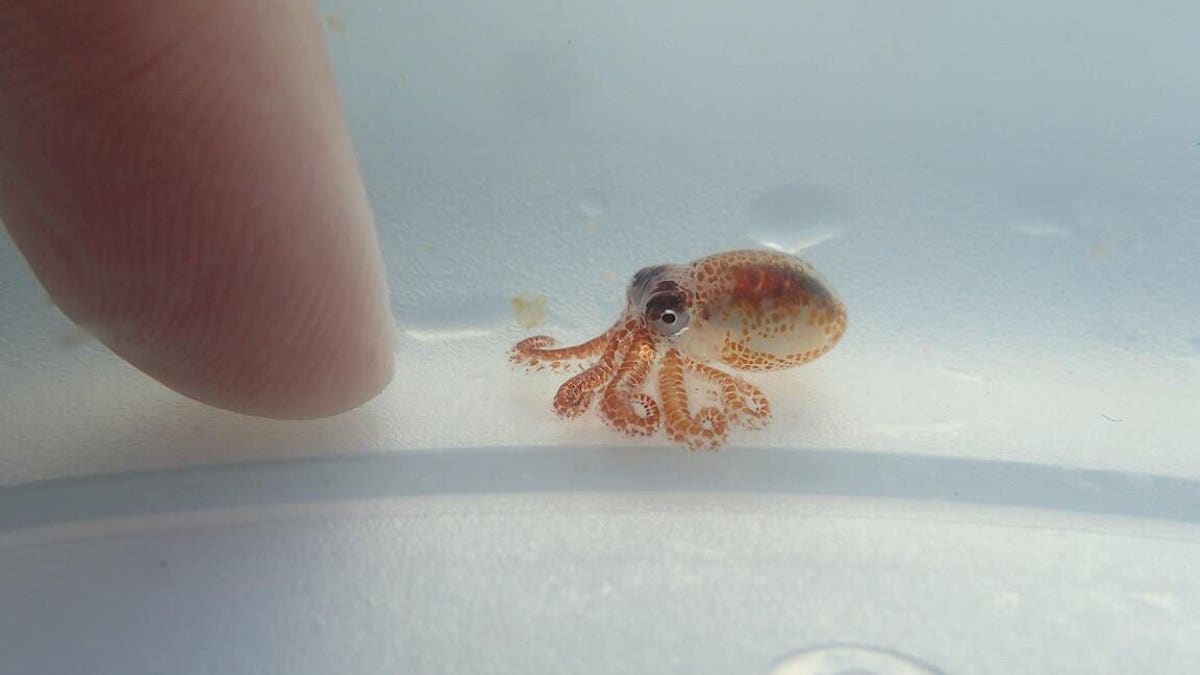
Two tiny octopuses were discovered floating on trash off the coast of Hawaii in August. (Ashley Pugh/National Park Service)
Marine biologists studying Hawaii's coral reefs discovered two rust-orange colored critters floating on plastic debris. The little creatures had eight tentacles — and, upon closer inspection, appeared to be miniature versions of octopuses.
Scientists with Kaloko-Honokohau National Historical Park on the Big Island found the pea-sized octopuses back in August.
"During a surface break from coral reef monitoring our Marine Biologists noticed something small when they picked up several items of floating plastic marine debris. This beautiful little octopus was found among the debris," the Hawaiian park posted on Facebook at the time.
GIANT GROUP OF OCTOPUS 'MOMS' DISCOVERED DURING DEEP SEA EXPEDITION: 'IT'S SUICIDE'
The scientists scooped up the small marine animals and placed them in a plastic container full of water. On their next dive, they returned the octopuses back into the ocean "in a small protected space." Kaloko-Honokohau National Historical Park marine ecologist Sallie Beavers told The Associated Press one squirted a tiny bit of ink when they released it in the ocean.
They later confirmed they found the second octopus on top of plastic debris attacking and killing a crab.
"Maybe they aren't so cute?" the national park joked on social media, sharing a photo of the unique sight.
Images of the spotted cephalopods went viral when the U.S. Department of the Interior posted a photo of one on Twitter this week.
"Who knew an octopus could be so cute!" the government agency wrote in a tweet, which has been shared by hundreds of people.
Beavers believes they were likely either day octopus or night octopus, both species commonly found off Hawaii.
Day or night octopuses can weigh up to 12 pounds as adults, with arm spans of 3 feet. They're successful hunters, and use venom to prey on crabs, small crustaceans and other fish, because of their camouflage-like ability. Their translucent skin can transform and blend into their environment, typically coral or rocks.
"As the prey is held fast by the suckers, a toxin produced by the salivary glands is injected to paralyze the prey and additional secretions containing digestive enzymes liquefy the flesh. The octopus then uses its parrot-like beak to tear the softened meat into small bites," the University of Hawaii Waikiki Aquarium describes in a blog post.
SEAL SLAPS KAYAKER WITH OCTOPUS IN FUNNY VIDEO
Paul Clarkson, who oversees husbandry operations at California's Monterey Bay Aquarium, says day octopuses are especially strong and intelligent.
"They like to huff and puff and blow water," he explained in a post online. "They're very willing to tear things up."
However, the small creatures have a very short lifespan — roughly a year — and they only breed once during that time period. Octopus babies hide under logs and other floating debris until they're a few months old.
Eben Schwartz, marine debris program manager for the California Coastal Commission, previously told Fox News eight million metric tons of trash enter the world's oceans every single year.
"We see plastic throughout water columns, on the ocean floor, deposited in polar ice caps," he explained.
The Associated Press contributed to this report.




















